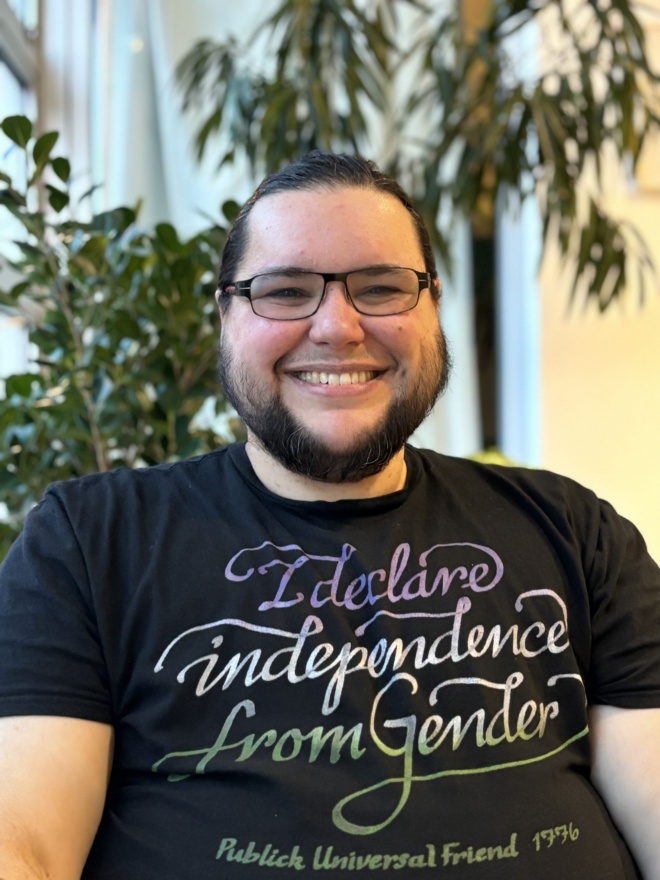
Yoga while Trans*: Sthira Sukham Asanam
To celebrate our newest 2024 Queer & Well program offering, Yoga while Trans*, led by the founder of Chakra Rainbow Yoga, Adrien Joyner, shares more about and Sthira Sukham Asanam what folks can expect in our March workshop offering, meant for all trans, intersex and gender nonconforming folks.

Yoga while Trans*: Sthira Sukham Asanam
The Yoga Sutras of Patanjali are the earliest known treatise on yoga, written sometime before 500 CE. This philosophy, today known as Raja Yoga, attempts to provide a comprehensive guide for reaching enlightenment. Raja Yoga primarily revolves around meditation and includes ethical, philosophical, and physical practices. Only three of the 196 Sutras mention asana, the postures that most people today picture when imagining yoga. The first and most important of these sutras reads “Sthira Sukham Asanam,” meaning sit for meditation with steadiness and ease.
Asana, literally meaning seat, has become a broad term encompassing all of the various postures yogis have developed in the generations since Patanjali. The Yoga Sutras state that an asana is a pose for meditation specifically. Keeping the mind calm and focused is essential to every asana. This meditative mindset differentiates yoga from simple stretching, gymnastics, and other similar movements. One interpretation of Sthira Sukham Asanam is that asana balances effort with relaxation and strength with flexibility. Our asana practice challenges us to find inner focus and resilience in each mental and physical posture.
Patanjali’s commentary on his Sutras only describes a few of the thousands of postures practiced by modern yogis worldwide. The original intention of the asana practice was to prepare the body to spend hours at a time entirely still in meditation—in other words, to make the body comfortable enough to ignore. At the same time, the spirit strives for liberation from the material world.

Photo of Adrien Joyner
I first read Patanjali as part of my yoga teacher training. Though Raja Yoga is far removed from the types of yoga I’ve practiced in my own life, Sthira Sukham Asanam put words to a concept I’d been practicing in yoga classes for years. In each pose, specific muscles must work to hold the body in position, and any muscles not needed for that work should be relaxed. I was constantly grinding my teeth or clenching my hands into claws early in my practice. The more complex the posture was, the more unnecessary effort I’d catch myself putting in. Noticing and moderating these unconscious and superfluous tensions improved my time on the mat; it began to carry into sitting at my desk at work or laying in bed trying to sleep.
As a trans person, a fat person, and a person with chronic pain and anxiety, finding comfort in my own body has been a lifelong challenge. My yoga practice helped me notice and sort through the many tensions I’d been ignoring in my body. Each asana asks the question differently: how much of this effort and tension is necessary? Where can we let go of an effort that’s not needed? Is the stress we put on ourselves beneficial?
Although asana is often represented as a single, static, and idealized form, each asana is a range of possible forms with a specific goal and benefit. The most advanced or ideal form of many asanas is beyond the capabilities of most people. Attempting to force ourselves into a posture that doesn’t work for our bodies directly contradicts the central ethical tenant of yoga: nonviolence. Our yoga practice demands that we listen to our bodies to locate the version of each asana that feels steady and comfortable in the present moment. In the long term, yoga is a process where we can gradually and gently work to improve each asana, feeling its benefits along the way.
The single most frustrating and upsetting part of my negative relationship with my body was feeling like I had no agency over it. Yoga helped me to reapproach my body with gentleness, understanding, and achievable expectations. Letting go of my harsh urge to control and punish it allowed me to feel I had real agency over my body for the first time. It was the Sukam that I had been missing, the rest to complement the effort, the softness to complement the strength. As a teacher now, I want my students to feel empowered on their mat and to use their agency over their bodies to be gentle with themselves.
Join me for Yoga while Trans*: Finding Steadiness and Ease in the Body on March 12, 6-7:30 PM at the SF LGBT Center. This free, gentle yoga class is intended for all trans, intersex, and genderqueer folks. Beginners welcome! RSVP Here.
Letting go of my harsh urge to control and punish it allowed me to feel I had real agency over my body for the first time.

